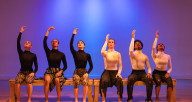UPDATE: The new seechicagodance.com will launch March 31st. Click here to learn more.
New works by company artists premier in Winifred Haun & Dancers “First Draft: new works by Chicago dancemakers”
Winifred Haun & Dancers’ began their 2023 season with “First Draft: new works by Chicago dancemakers,” which ran March 3-5 at Links Hall. Company members Julia Schaeffer, Amanda “Mandy” Milligan and Assistant Artistic Director Summer Smith presented work alongside guest choreographers Lonny Joseph Gordon, Mariah Eastman, Sarita Smith Childs, and Silvita Diaz Brown.
The program opened with “Fragments of Solace'' by Julia Schaeffer. The piece begins with seven dancers like a school of dolphins contracting and extending their spines, moving in rippling waves across the floor. A pattern emerges to the sound of scratching violins, separating one or two dancers from the pack. They leap into the foreground, arms swinging, legs sweeping in circular motions. In slow motion, dancers capitulate forward, like a body tumbling over large rocks. “Fragments of Solace” gets the heart racing with high energy, constant movement and crisp formations.
A solo work by Sarita Smith Childs titled,“It Is All So Different” finds dancer Kelly Kosiek battling invisible inner demons to music by Icelandic indie-folk rock/chamber band Arstidir. Alone with only a black aluminum folding chair, Kosiek slowly loses her mind, using her hands to pull “thoughts” out of her hair. She raises the chair overhead, flings it around, and places it back down and assaults it with harsh swings of an arm, like throwing punches. Kosiek traces a timeline of regret on the floor with a toe before keeling over the back of the chair, spent and exhausted.
Kelly Kosiek delivers a powerful performance in Childs’ “It Is All So Different,” a work that is both thought-provoking and physically cathartic.
Mandy Milligan’s “I Remember Damage” is a duet featuring Milligan and Virginia VanLieshout. Syncopated saxophone riffs accompany an intimate conversation between the two, one’s movement eliciting the movement of the other. Metaphors abound, particularly that of “mutual support,” or a lack of it, in a series of cradle lifts and drops that has a body hitting the floor, hard, three times, each accompanied by the cringe-inducing sound of flesh and bone slapping gracelessly against wood. Although lacking the energy or sharpness of movement of the previous two works, “I Remember Damage” is an engaging visual metaphor for a toxic relationship.
“Inclined to Decline” by Mariah Eastman has four dancers lashing out at rejection. “I reject your rejection!” shouts one as they flip another dancer over their shoulder, then take a fighting stance. Collectively they form a robotic phalanx that marches forward, stopping to spin furiously from one side to the other like a possessed washing machine. The piece ends too abruptly, but a mention in the program tells me that this is an excerpt, the full work, premiering in July of this year. This is good, because Eastman’s “Inclined to Decline” left me wanting more.
From the second it begins, “Bench 2023” by Lonny Joseph Gordon holds you in its grasp. Gordon, in a newsboy cap and gripping a wooden cane, sits to the right of the audience cloaked in shadow while dancer Myles Harris sits solemnly on a long bench center stage. “Achem, hmmph, ohhwoooo,” gurgles Gordon under his breath. The sounds poke and prod at Harris. He flinches, trembles, then is “blown” off the bench by a loud “Whaaaaaaaa!” by Gordon—Vocal puppetry! The sounds of sucking, gasping and crawling feet send Harris into a tailspin, running around the room. Loud taps from the cane cause Harris to lift the bench above his head, resembling Atlas of Greek mythology. Unique and captivating, Gordon’s “Bench 2023” is a masterclass in connecting sound and movement.
Silvita Diaz Brown’s “Ellas y Yo Mexicanas: Frida” is a tribute to painter Frida Kahlo, with three dancers—Ileana Nadine Mauricio, Juan Enrique Irrizary and Brown—wearing long, flower-print shawls, skull earrings, carnations threaded through their hair and penciled-in, connected eyebrows that resemble Kahlo’s signature look. Each dancer takes a solo. They slither and twirl, trying to jump out of their own skin. Arms flap explosively! Spines bend like rubber. The costume is wonderfully transformative, at one time becoming the feathered fan of a peacock’s tail. The sultry soundtrack by local musicians Wiebe Ophorst and Marshall Greenhouse is a perfect complement to the piece. Live guitar accompaniment (not specified who) only makes the piece better. Brown’s “Ellas y Yo Mexicanas: Frida” combines strong performances with vibrant colors to create the feeling that you are watching a Kahlo painting come to life!
“Nervous System Breakdown” by Summer Smith is vigorously energetic. The full company of seven dancers, like fighter planes, circle a target, stall midair, then peel off and engage in an intense dogfight that has them running towards each other in a crosshatch pattern, barely missing one another. In front of a projected background showing water full of garbage and floating water bottles, the dancers form an assembly line of rolling human bodies that quickly morphs into a human staircase, with one brave, shaking spelunker daring to ascend. Smith’s “Nervous System Breakdown” moves at a breakneck pace but slows down at key moments to create stunning visualizations of bodies forming mountains, rivers, planes, birds, machinery, and all manner of pleasing imagery.
If a chain is only as strong as its weakest link, then I doubt that even Superman could break apart the bonds formed by Winifred Haun & Dancers. That Haun played a supporting role and included no choreography of her own is testament of a confident director. Projected pre-show images of the company’s heyday create pangs of nostalgia, but, after “First Draft” one is left with nothing but optimism for the company’s future.


